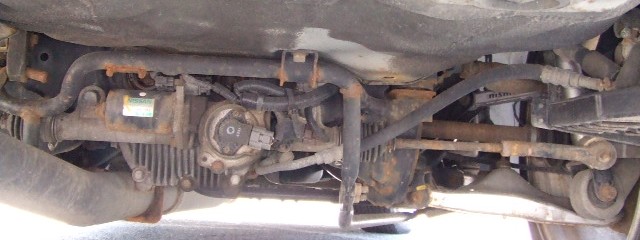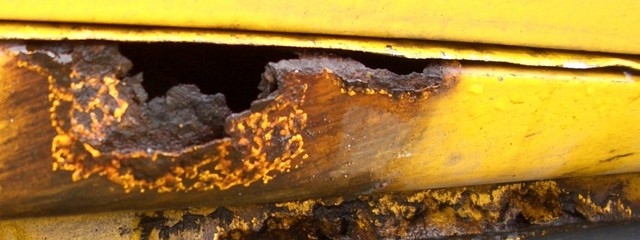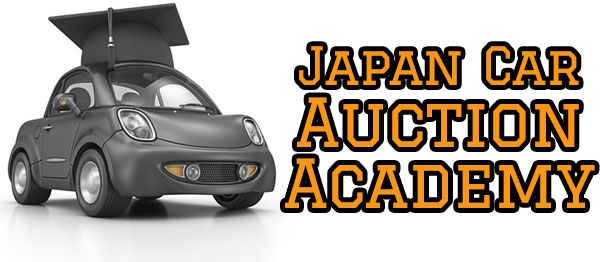When you read the word “corrode”, your mind probably starts to imagine these vehicles as real “rust buckets”, but that is often not the case. The auction inspectors tend to be quite strict, and the Japanese people themselves look after their vehicles well and replace them earlier than most other people around the world. Not to mention the fact that grit is only rarely used and salt never used on roads even in the snowiest parts of Japan.
However, when looking at cars in the Japanese car auctions, it is important that you understand the different terminology that is used to refer to corroded metal. After all, most of this kind of damage occurs under the vehicle, which means that you may well not be able to see anything in the exterior photos of the car.
At the most basic level, there are three levels of damage associated with corroding metal:

Rust
This is the most mild level of deterioration. “Rust” (sabi in Japanese) on a car auction sheet simply means:
“Surface orange discoloration”
If you look at the photo of the underside of this car, you can see areas of rust, particularly at seams in the metal.

Corrosion
This is more severe than "rust". When a Japanese car auction inspector refers to “corrosion” (fushoku in Japanese), he means:
“Orange discoloration of the metal that is flaking away”
The key phrase here is “flaking away” which means the deterioration is not just a change of color on the surface.

Corrosion Holes
As corrosion progresses, and the metal deteriorates and flakes away, eventually it will eat right through the metal, resulting in a hole. In Japanese, the car auction inspector will refer to this as a fushoku ana (fushoku = corrosion, and ana = hole).
Cars are usually graded 2 if they have corrosion holes, but our translations sometimes spot them on cars of other grades as well.
Severity of rust or corrosion
The car auction inspectors use a system of letters and numbers to describe different kinds of damage (dents, scratches etc) as well as to refer to deterioration caused by corroding metal.
Rust is designated with the letter “S” (which comes from the Japanese word for rust – sabi), and corrosion is designated with the letter “C” (from the English “corrosion”).
Unless the level of damage is extremely trivial, the letter will usually be followed by a number that indicates the severity of the damage. So, “S1” is mild rust, “S2” is medium rust, and “S3” is severe rust. The same system also applies for corrosion.
In the case of corrosion holes, this will be written either completely in Japanese, or using the letter “C” followed by the Japanese kanji character for hole.
(Remember that we do not expect you to be able to read Japanese, which is why we provide a professional translation service. It’s all part of our goal to make buying from Japanese car auctions smooth and stress-free for you.)
Extent of rust / corrosion damage
In addition to the severity of the damage from corrosion or rust, the auction sheet may also give an idea about the extent of the damage as well.
If the damage is on the exterior, the auction inspector may draw on the car auction sheet to show where and how large the area is. If the rust or corrosion is in an area where it cannot be drawn on the exterior condition "map" like this, the inspector will sometimes write comments that indicate its extent.
Examples of these comments are:
- Rust on the suspension
- Rust on the muffler
- Area of rust
- Patches of rust
Unfortunately, the inspectors do not always write much detail about the extent of rust. For example, the auction sheet may simply say, “rust underneath” leaving you to wonder what the extent of the rust is.
However, even in this situation, you can get a feel for how severe the condition is likely to be based on a couple of factors. Firstly, if the car has higher mileage, or secondly is in a place where lots of snow is common, then we should be a little cautious and assume a worse-case scenario.
If you are ever unsure about what the auction inspector’s comments mean, you can always contact us via email or through our online auction system and we will be happy to help.
How to quickly identify problem cars
Given that comments are often written in Japanese, you may be wondering whether there is a quick way to screen for rusty or corroded cars before you get a translation.
Here is a quick and easy way of elimination obvious problem cars:
- Don't bid on any grade 2 cars. (Remember, that grade is awarded for corrosion holes!)
- Look for the letters S or C in the auction inspectors' comments. (You may not be able to read the Japanese around these letters, but you know that S is rust and C is corrosion).
- Look for those same letters S and C on the car map.
Of course, these three tips are not going to protect you from all the cars that have rust or corrosion, but you will be able to screen out a lot. Then the rest you will catch when we translate the inspection report for you.

We find that the most successful importers really understand how it all works - from the auction to the ship and beyond. Don't get left behind!


